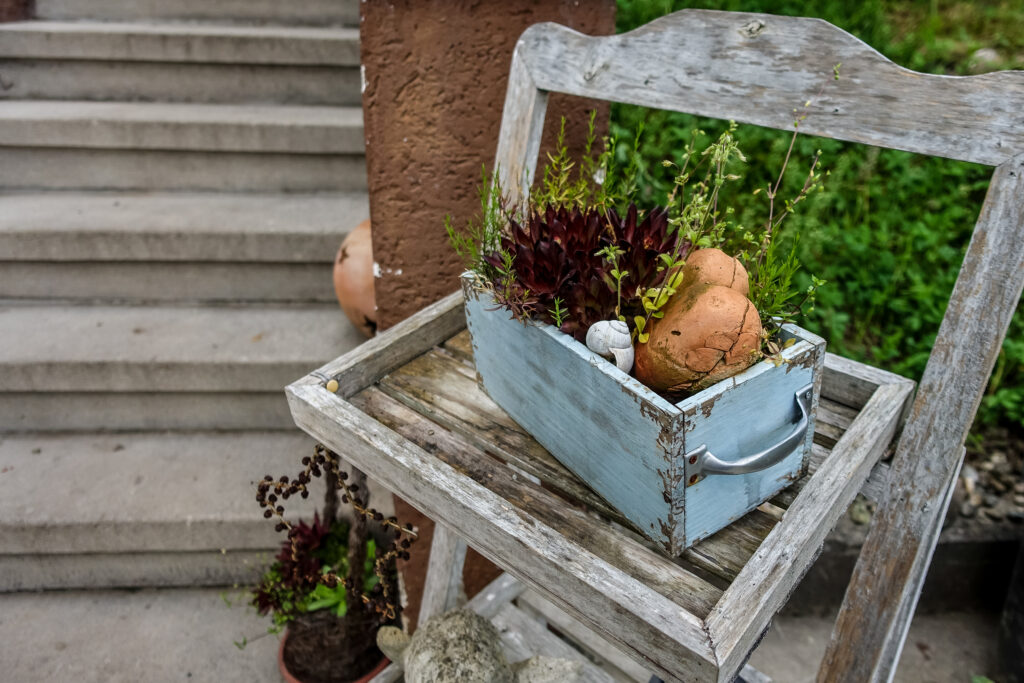Creating beautiful plant displays doesn’t require expensive custom shelving or high-end furniture. With resourcefulness and creativity, thrifted items can be transformed into stunning thrifted plant shelf transformations that showcase your botanical collection while maintaining budget discipline. This approach not only saves money but also adds unique character and sustainability to your indoor gardening journey.
The Advantages of Thrifting for Plant Display Solutions
Sourcing secondhand items for plant shelving offers numerous benefits beyond simple cost savings.
Show Image Alt text: Assortment of creatively repurposed thrift store finds including a ladder, wooden crates, and vintage suitcases arranged as plant shelves with various potted plants
Consider the benefits of a thrifted plant shelf transformation, where creativity meets sustainability, providing endless possibilities for your home decor.
Benefits of Budget Plant Shelf Approaches
- Unique aesthetic impossible to replicate with mass-produced items
- Environmental sustainability through reuse of existing materials
- Character and history that adds storytelling elements to your decor
- Flexibility for customization without fear of “ruining” expensive pieces
- Guilt-free experimentation with different styles and approaches
Where to Find Thrifted Treasures with Plant Shelf Potential
Successful thrift-hunting requires knowing where to look for items with transformation potential.
Prime Hunting Grounds for Cost-Effective Decor
- Thrift stores (Goodwill, Salvation Army, local charities)
- Estate sales for higher-end vintage pieces at discount prices
- Yard and garage sales for neighborhood treasures
- Online marketplaces like Facebook Marketplace or Craigslist
- Curb alerts and free community exchange groups
- Construction salvage yards for architectural elements
What to Look For: Items with Plant Shelf Potential
- Ladders (wooden or metal) for vertical displays
- Wooden crates for stacking or wall-mounting
- Side tables with solid construction
- Bookshelves that can be modified
- Vintage suitcases for unexpected plant platforms
- Old drawers removed from damaged dressers
- Industrial metal pieces like wire racks or carts
Transformation Techniques for Thrifted Finds
Converting secondhand items into functional plant displays often requires some modification.

Essential Tools for Upcycled Materials
- Basic tool kit (hammer, screwdriver set, pliers)
- Measuring tape and level
- Sandpaper in various grits
- Primer and paint or wood stain
- Waterproof sealant for moisture protection
- Cleaning supplies for initial preparation
Common Transformation Processes
- Thorough cleaning to remove dust, grime, and potential pests
- Structural assessment to ensure stability for plant weight
- Surface preparation through sanding or stripping as needed
- Reinforcement of weak joints or supports
- Moisture protection application for wood surfaces
- Decorative finishing with paint, stain, or other treatments
- Hardware updates for improved function and appearance
Five Cost-Effective DIY Shelving Projects
These budget-friendly projects demonstrate the potential of thrifted materials for plant displays.
1. Ladder Plant Display
Materials:
- Thrifted wooden ladder
- Sandpaper and paint/stain
- Wood planks (can be reclaimed)
- Waterproof sealant
Process:
- Clean and sand ladder thoroughly
- Apply paint or stain as desired
- Cut wood planks to fit ladder steps
- Seal all surfaces for moisture protection
- Position planks on ladder steps
- Arrange plants by light needs (sun-lovers at top)
2. Stacked Crate Shelving
Materials:
- Wooden fruit or milk crates
- Sandpaper
- Paint or stain
- Fasteners for stability
Process:
- Clean and prepare crates
- Arrange in desired configuration
- Secure together with screws or brackets
- Apply uniform finish or intentionally varied finishes
- Add small risers inside for varied plant heights
3. Repurposed Drawer Plant Steps
Materials:
- Drawers from discarded furniture
- Cleaning supplies
- Paint or decorative paper
- Waterproof liner material
Process:
- Remove hardware if desired
- Clean thoroughly and repair any damage
- Paint exteriors and/or line interiors
- Arrange in stair-step formation
- Secure together if needed for stability
- Add moisture protection before adding plants
Styling Tips for Budget-Friendly Plant Displays
The presentation of your thrifted plant shelves significantly impacts their perceived value.
Elevating Affordable Displays
- Group similar items together for collective impact
- Create intentional color schemes through painting or plant selection
- Add small decorative elements that complement the vintage aesthetic
- Position dramatic or unusual plants as focal points
- Layer plants at varied heights for dimensional interest
Balancing Eclectic and Cohesive Design
- Connect disparate items through consistent color palette
- Use similar containers across different shelving pieces
- Maintain consistent plant types or themes
- Create visual rhythm through repetition of elements
- Consider the overall composition from multiple viewing angles
Practical Considerations for Upcycled Plant Shelves
Ensuring functionality remains as important as aesthetics in thrifted plant displays.
Adaptation for Plant Health
- Consider adding drainage solutions for direct planting
- Evaluate light exposure at intended placement location
- Ensure adequate support for heavier plants
- Create waterproof barriers between plants and wooden elements
- Test stability before adding valuable or fragile plants
By embracing budget plant shelf approaches through creative thrifting, you not only create distinctive displays for your plants but also participate in sustainable design practices that reduce waste while maximizing style. These cost-effective decor solutions prove that beautiful plant arrangements are accessible regardless of budget constraints.




